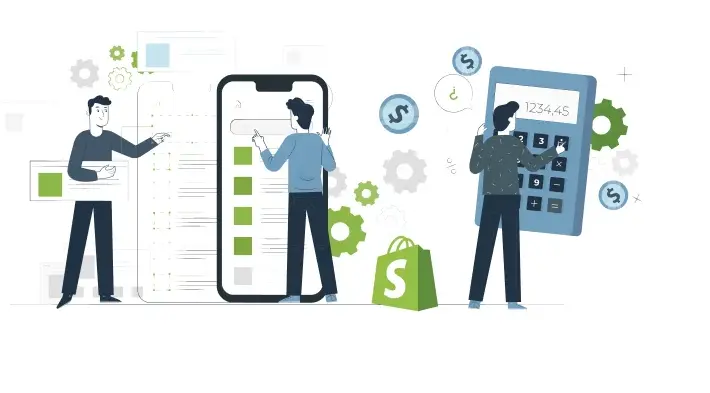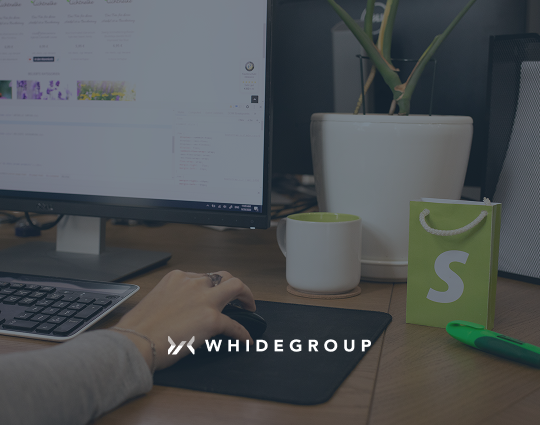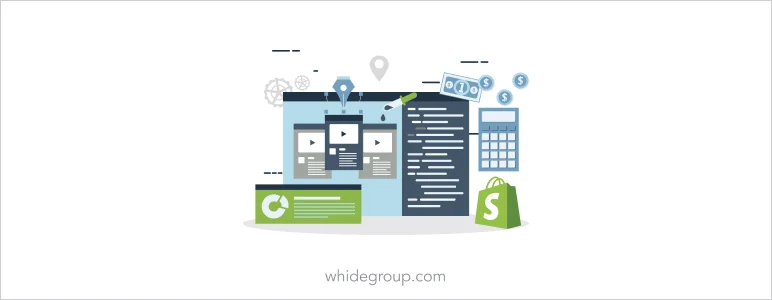Custom Shopify App Development Cost:
How Shopify Developers Determine the Price for Custom Apps

Custom Shopify App Development Cost:
How Shopify Developers Determine the Price for Custom Apps
Share post
During 2021, we at Whidegroup were seeing a significant increase in the number of requests for a custom Shopify app development. These requests frequently come with the desire for a precise Shopify app development cost estimation.
The thing is, in practice it is almost impossible to give a precise cost estimate for the development of a custom app before we know all the details of the project needs. To bridge the cost estimation gap, we decided to create this detailed guide for estimating the development time and cost that you should expect when addressing Shopify development companies. Continue reading and you will learn:
And, of course, we will help you to get an idea of the final Shopify app development cost to expect.
Table of Contents
ToggleBefore telling the client how much a custom Shopify app will cost, it is necessary to clarify the maximum number of requirements to the future app. In the case of Shopify apps, there are several factors that directly affect the final cost which we try to figure out first.
The more complex the functionality of a future app, the more it will cost you.
If you want to develop one simple function, like a product filter or add a customer feedback form to your store, usually, it won’t cost you a fortune. At the same time, though, these simple features are usually already available in the Shopify App store for you to add on. You can also check our two-part Top Shopify apps compilation, where we gathered only the best apps that will help you meet almost any need.
If we talk about the cost to develop a more complex custom functionality, it’s quite reasonable that it is going to be higher than the cost of an add-on app. So how do we actually determine the future cost of a Shopify app to give an estimation that is as precise as possible?
Now, when talking about the “types” of Shopify apps, we do not mean their features, or the type of ecommerce niche it is created to serve. What we mean here is the app’s purpose.
Are you creating your own Shopify app to serve the one and only store? Or maybe you have several Shopify ecommerce stores that need that one exclusive app? Or you just have a brilliant idea for the app which you want to develop and share with all Shopify merchants? Do you get it?
The thing is, Shopify gives you an opportunity to build three different types of apps: Public App, Private App, and Custom App. Every type determines the way an app will be developed and who can use your app in the future. Let’s review each of them in more detail:
Public Shopify Apps are those that have passed the Shopify App review process, are publicly available, and can be installed on numerous Shopify websites. Actually, there are two types of Public apps – listed and unlisted. You can see listed Shopify apps in the Shopify App store while unlisted ones are not in the App store listings but can be accessed by the link and installed the same way the listed apps are.
Private Apps are developed with the only store (and its needs) in mind. Such apps can’t be installed on other online shops or used by other merchants. To get a Private app for your store, you will need to provide a developer with API access to your store and access to your Shopify admin.
Custom App development is the best option for you if you want to add a unique feature to your Shopify store but are not comfortable with giving access to your store admin or API access to external developers. These apps do not need to pass the Shopify App review process and are not listed on the Shopify App Store. These features are developed exclusively for a single store and, as well as private ones, can’t be installed on other stores.
Although the type of the app you need doesn’t directly influence its final cost, the development process for each type has its own intricacies and characteristics. This means that the time required for development may vary slightly.
In fact, this stage determines not only the final cost of a project, but also the quality of the final product. In general, there are three options for organizing the development process:
How do these options differ? Let’s take a look at each of them separately.
Most often, in order to hire a close-knit team of developers, you will have to find a development company that has decent experience in Shopify app development.
Why a company? Let’s take a look at the main benefits of such collaboration:
Today, using freelance services is just as popular as working with companies. A business will often choose a freelancer because:
However, there is another side of the coin. Depending on the technical requirements and overall complexity of your future Shopify app, you may need to hire one to five freelancers (designer, developers, etc.) to create your development team. In order to develop a quality product, specialists working on the project need to communicate with each other. This means that you will have to first find and hire every freelancer, and later establish contact between them potentially being the go-between and having to understand the technical aspects to communicate.
If you hire specialists from different countries, mutual understanding between them can turn problematic for many reasons. Accordingly, there is a risk of misunderstandings between remote employees and other issues like language barrier or work schedules that will negatively affect the quality of the final product.
If you answer “Yes”, this only means that you do not need this guide. Having enough knowledge about the intricacies of the Shopify app development and, of course, practice, you can start the development right away and without third-party assistance. Here is your answer to the main question of this article, namely “how much does it cost to build a Shopify app?”. For you, it will account to 0. Instead, you may be interested in reading our definitive guide on how to create a custom Shopify theme.

Generally there are two common ways to calculate the costs of web development of any type: fixed price and time and material.
Fixed price model is applicable to projects with a clear or default functionality. These are the projects that have:
This option is often a good idea for startups and small scale projects.
It is important to note that nobody needs to develop an app with default functionality anymore. Such apps are already available either with Shopify out-of-the-box features or in the Shopify App Store. So every quote request we receive from potential clients concerns the development of complex solutions and needs to be individually researched and estimated.
That is why Whidegroup uses the Time & Material pricing model for all our projects. We know that it is simply impossible to precisely estimate the cost of a Shopify app development without having a clear technical task, which can be compiled only after a thorough interview with the client. Based on the detailed technical task, we can estimate the time (in hours) needed for the development and implementation of the requested app.
The Shopify app development process usually includes five stages. The number of stages mainly depends on the project requirements, which become clear after the initial interview.
After the initial interview, our major task is conducting a deep analysis of the market and the client’s niche. As the result of the research we:
This stage usually takes up to 40 hours.
An app design is not just about the way users will see your app. It is more about the way they will interact with it. The greater the user experience your app provides, the more likely it will succeed.
There are two steps of a Shopify app design creation – wireframing and prototyping:

Rare apps don’t need a design. Such features are integrated into the website backend and do not require a store manager or a customer to directly interact with it. All other apps always require a visual part either on the website’s fron-tend, or back-end, or both of it, depending on who is the end user.
Now that the app’s design is ready, we start working on the custom logics development. Again, depending on the app functionality, the development process might look different and take more or less time to be completed.
In the next section we will show an example of how much time the development of two different Shopify custom apps might take, from our own experience.
Testing is vital, as you know. Different teams can have different approaches to quality assurance on their projects. As for Whidegroup, to verify that every aspect of the developed Shopify app works properly and actually performs expected functionality, our QA specialists thoroughly test the app at every stage of development.
In general, there are two types of testing we perform for every custom Shopify app:
After the final tests are performed, we are ready to submit and launch a new app.
Now, your app is ready to be installed and used on a Shopify store. The next steps will depend on the actual type of an app. If it is supposed to be a public Shopify app, you’ll need to prepare it for the Shopify App Store submission.
To be successfully submitted, the Shopify App Review team must review your custom Shopify app and approve it for further publication. For more information on the app submission process, you can visit the official resource.
Although, even if you are building a Shopify private app, before launching it, you should make sure it meets the vital requirements. So, every Shopify app must:
Done? Congratulations. You now have your new Shopify feature ready for installation and use.
As we’ve already mentioned, it is nearly impossible to estimate the time required to build a custom Shopify app before exploring all requirements to the future functionality. However, we’ll try to uncover time and price estimation peculiarities based on our own experience.
Lately, we’ve developed two totally different custom Shopify apps.


Of course, the apps mentioned were not too complex to implement and didn’t have a long list of required functions so the hours spent in development reflected as such. Our portfolio also includes several, more complex, successfully developed apps, so we know that some high-level custom Shopify apps can take from 2,000 to even 20,000 hours to be developed, as well as discussing the alpha/beta version of the final product.

After reading this article, you know that the cost to develop a custom Shopify app mostly depends on the time required for its development.
When searching for the Shopify app development team to assist you in the project, you’ll find out that their rates can differ significantly.
Generally, the rates for Shopify app development services start at $25/hr, and can reach as high as $200/hr. It usually depends on the professional qualification and size of the company you choose. So, how much does it cost to build a custom Shopify app?
Type of a company
Boutique ecommerce development company
Big name ecommerce development company
Web development company
Type of a company
Average ratesBoutique ecommerce development company
$50-$100Big name ecommerce development company
$100-$200Web development company
$25-$100Type of a company
Estimated cost for custom app development (~100 hrs)Boutique ecommerce development company
$5,000-$10,000Big name ecommerce development company
$10,000-$20,000Web development company
$2,5000-$10,000If you plan to create your own Shopify app, the cost calculation is not the only issue you will face. Besides the Shopify app development cost calculation you will need to define the final list of features, have a clear understanding of the competition in the niche, and, of course, choose a partner providing Shopify development services and having the most reliable experience to work on the development of your app. Weighing all pros and cons and choosing the best Shopify developers only by the cheapest rates or location is not the best decision. So before signing the agreement with a team, make sure they have relevant experience in your niche and won’t charge you extra money. Approaching several agencies with your inquiry is also a good idea.
If you need any additional help with your project, Whidegroup is ready to assist you and answer any questions you might have. Just send us an email or reach us via the contact form.
Share This Article

 How to Reduce Bounce Rate: Shopify-Specific Aspects to Fix
How to Reduce Bounce Rate: Shopify-Specific Aspects to Fix
Important! No estimate can be 100% accurate. Therefore, deviations from the declared time estimate by 10-20% (up or down) are usually implied.